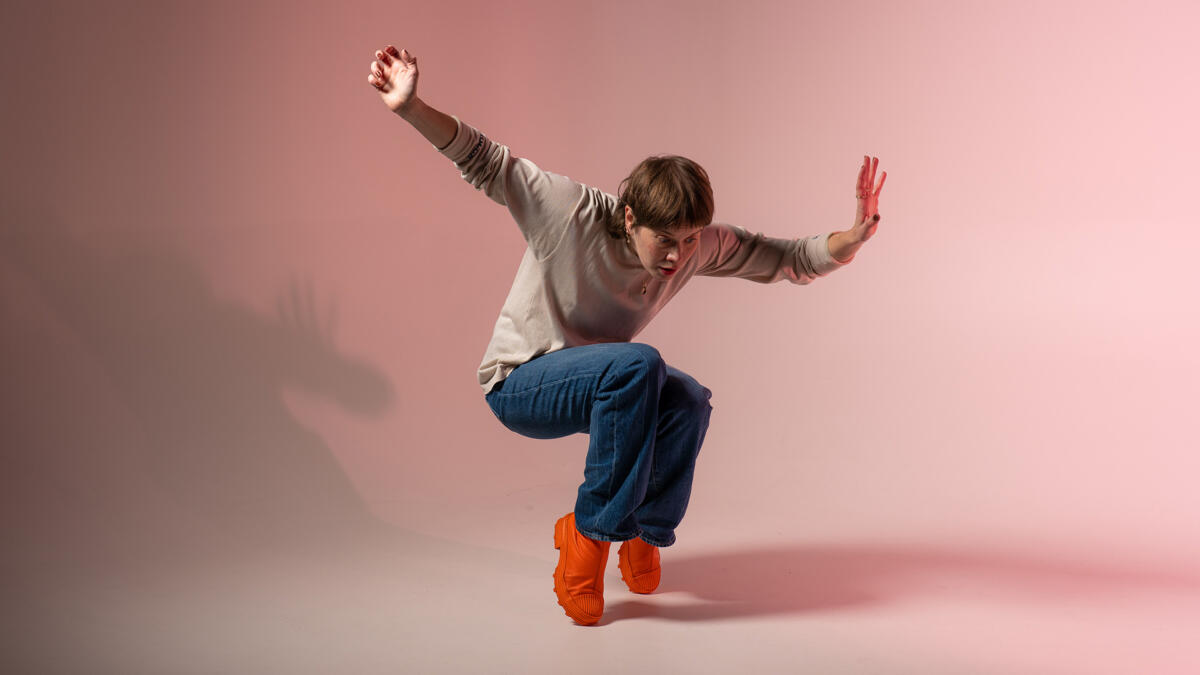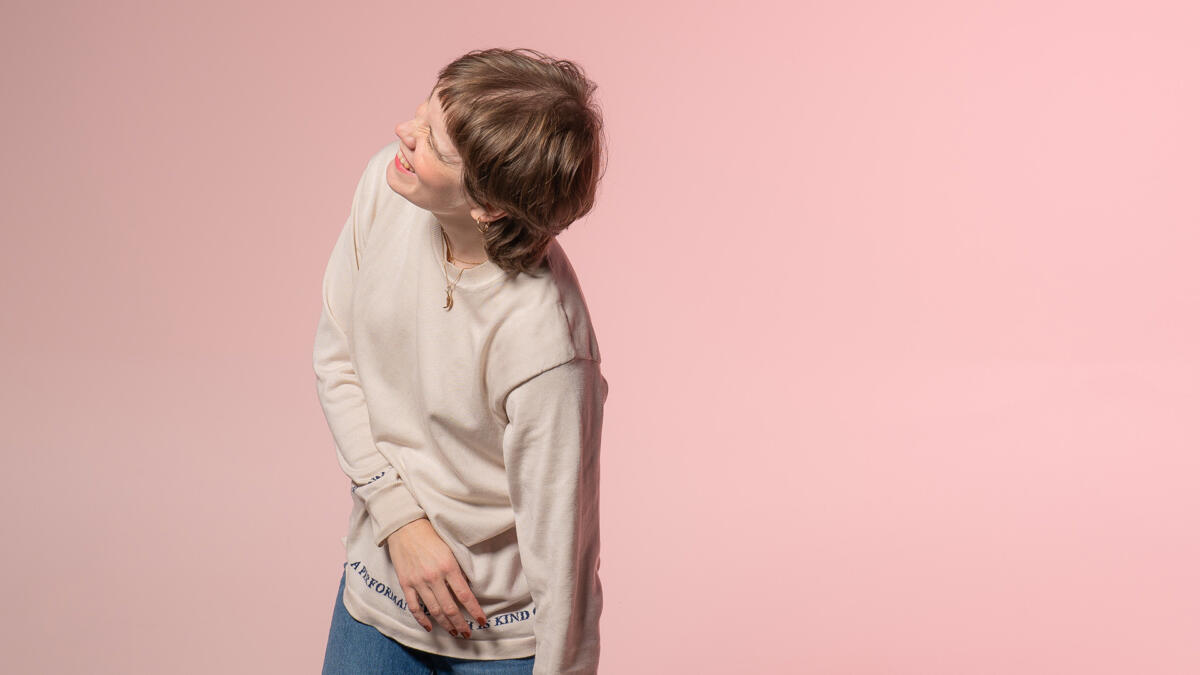Choreography alum: Vast production resources encouraged us students to think bigger
Laura Jantunen began developing her own movement practice while studying at the Theatre Academy of Uniarts Helsinki. Read about her journey to the master’s programme in choreography after 10 years of working life.

Tell us about yourself and how you ended up studying at Uniarts Helsinki.
I am Laura Jantunen, a multidisciplinary artist and choreographer. Since I was a child, I have wanted to dance professionally. From the dance department of the Sibelius upper secondary school in Helsinki, I went on to study at the North Karelia College Outokumpu (now Riveria) and graduated as a dancer in 2011. I worked as a dance maker for ten years before applying to the Uniarts Helsinki to study choreography.
Tell us something you remember about applying.
I don’t have a bachelor’s degree, but you’re still eligible to apply to the master’s programme in choreography if you have worked professionally in the field for a certain number of years and have studied for at least 60 credits. I was still 30 credits short but was able to complete them in the six months before applying. Among other things, I studied philosophy at an open university.
Something else I remember particularly was my decision to do my absolute best on the preliminary assignments. I wanted to make sure that I really had thought every last detail through before handing them in.
What was it like to study choreography at Uniarts Helsinki?
About half of the studies were lectures and the other half was practical work. The practical work consisted of four different projects: a solo project, an artistic collaboration project, a demo project, and a thesis project.
Lectures covered topics such as the history of dance and choreography, dramaturgy and philosophy. There were also a number of optional studies and collaborative courses.
What do you think was the best thing about studying?
Simply put, the best thing was learning something new every day in such a tangible way. After graduation I missed this unique state of learning.

What was your most memorable experience during your studies?
For me, the most memorable experience was the artistic collaboration project (ACO), a five-week group work between students from different programmes. Besides the choreographer, the team included dancers, a sound designer, a lighting designer, a set designer and a costume designer.
Halfway through the process there was to be a feedback session with the teachers. At that point we had been working on the piece for 2-3 weeks. The night before the feedback session, I had come to the conclusion that something in the piece wasn’t working and that we should go in a different direction. I shared my decision with my team and later, at the feedback session, with my teachers. Never before had I changed everything just a couple weeks before the premiere. I’m glad I found the courage to do it and that my team supported my decision.
When you are studying, I think you have to allow yourself to fail. Even if I had been unhappy with the final piece, I would have learned something about teamwork and about myself in the process. The final piece was brilliant and it stayed with me because something completely new had happened in the process.
What was the most challenging part of your studies?
For me, the most challenging part was writing the MA thesis within the allotted two months. The studies as a whole were so intensive that I simply didn’t have time to start writing beforehand. Looking back, I wish I had had more time to delve into some of the new directions I was exploring in my work.
You worked as a dance maker for 10 years before studying choreography at Uniarts Helsinki. Was there anything surprising about studying compared to working life?
I really had to learn how to be a student again. As a working freelancer I was used to figuring things out and doing everything myself. Suddenly I had access to all these resources and a wide range of professionals at the Uniarts Helsinki. Of course I wanted to make the most of it, but it was something I wasn’t used to.
In the freelance field, it is surprisingly challenging to make productions on the scale that we get to practice during our studies. Instead, the ever-decreasing resources in the industry tend to push us towards creating solo projects or working in very small teams. As students, we were supported by extensive production resources, which allowed us to experiment with thinking bigger. And only if you practice thinking big can you eventually create bigger productions.
What advice would you give to someone applying to the master’s programme in choreography?
I think it is important to outline to yourself what you are trying to achieve as an artist and why, or why not, you would be a good fit as a choreographer. Two years is a short time in life, but if you’re not sure, it’s not worth taking someone else’s place. I would encourage you to reach out to alumni and ask about their experiences. Find out also if the content of the study programme is something that interests you.
Studying is intense, so clear your calendar to learn and develop as an artist
Studying is intense, so I recommend clearing your calendar and focusing on learning new things and developing as an artist. If you already have a particular area of interest, I would advise you to explore it systematically throughout your studies and develop it through each of your study projects. I initially focused on a movement practice called Authentic Movement, and later started researching my own movement practice, Somagics, and the scalability of these practices in choreography. This gave me a really good foundation to continue working on them after graduation.
What are you working on now and in the near future?
Right now I’m at the Kone Foundation’s Saari Artist Residency for another week. Here I have been working on a fool character and a series of performances called The Idiot Gardener (Idiootti Puutarhuri), a project I started in 2022. I am also making ryijy tapestries related to the same project, which will be exhibited in a museum in Jyväskylä and a gallery in Helsinki next year.
In November I will be teaching at the Zodiak Center for New Dance as part of the course series Indulge the Movement – Contemporary Dance for All. From January I will be working for six months with a grant from the Arts Promotion Centre Finland. In spring I will present my work Four Seasons: Spring at K17 Gallery in Sipoo. I am also working on a new solo and group piece to be premiered at a later date. And, of course, I am developing my own movement practice, Somagics, which began during my studies and is an ongoing part of all my work.